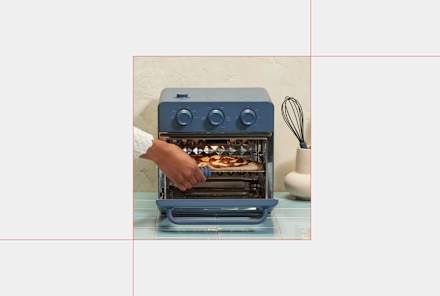Advertisement
How To Maintain Healthy Indoor Air (Even When The AQI Is Crazy High)


Considering that the average individual takes 20,000 breaths a day and spends around 90% of their time indoors, it’s easy to see why our homes play a major role in our well-being.
The American Lung Association explains that inhaling contaminated indoor air can have wide-ranging effects on our health. Fine particles or other airborne contaminants can impact our respiratory system and lead to coughing, watery eyes, scratchy throat, a runny nose, and more symptoms.
We need to prioritize the quality of air within our indoor spaces, particularly when outdoor air quality is poor (as it has been across the country for much of this summer). The pollution from outside can infiltrate our homes and pose a significant risk to indoor air, particularly if it already contains elevated levels of contaminants.
So, how can you protect your indoor air when outdoor air is compromised? Here's a quick checklist.
Keep windows closed and clean often (using the right products)
When outdoor air quality is poor, keeping windows and doors closed can help minimize outdoor air infiltration. However, you can’t exactly put a bubble around your house, so particles like smoke, dust, allergens, mold spores, and mycotoxins will inevitably blow inside from the outdoors. It’s up to us to actively work to keep particle levels low. Set up a daily, weekly, monthly, and seasonal cleaning schedule to keep your air quality as healthy as possible.
Building the right cleaning product arsenal is also a key piece of the home health puzzle. You want to make sure that the tools in your toolkit are up to the task of actually removing contaminants. Otherwise, you’ll be spending all of that time and effort cleaning but not improving your air.
A few great options to get you started include:
Invest in an air purification
Running air purifiers is a phenomenal way to reduce airborne pollutants in a home. These powerful machines help to remove contaminants so that they’re not circulating through our indoor spaces and making their way into our bodies. Not all air purifiers are built the same, though. You want to go with a unit that removes the maximum number of contaminants possible all of the time, not just some of the time.
The best option is to invest in a whole-home air purifier. These systems are installed at the home’s point of entry and will effectively remove contaminants from the air so that the HVAC system can run efficiently. This filters out particles for the entire home, eliminating the space requirements that smaller units have. As a bonus, they also offer a layer of protection for the HVAC itself by eliminating contaminants before they enter the system.
I'd also recommend avoiding burning candles or using aerosols at home when outdoor air quality is poor, as they can introduce additional pollutants.
Change and upgrade air filters regularly
Air filters are the first line of defense for the HVAC system and indoor air. They help eliminate dust and contaminants so they don’t continue circulating throughout your indoor space. If they’re past their time to be replaced, chances are that they’re packed full of all sorts of particles. This will affect their ability to filter, leading to lower indoor air quality. It can also put a strain on the HVAC system as it works overtime to pull air through the clogged filters. Changing them on time will help avoid this situation and ensure as much dust and particulate matter is removed as possible.
Before changing them out, make sure that they’re the highest-rated MERV filters possible for the specific HVAC system. You want filters with the technology to eliminate contaminants like mold spores from the air. Otherwise, they’ll circulate straight back into the home, creating a dirtier environment.
Reduce moisture
Mold can grow in as little as 24 to 48 hours on a wet surface. Working to eliminate as much moisture as possible is a key aspect of preventing microbial growth.
This can include:
- Cleaning up spills and pooled water ASAP
- Hanging up wet items to dry
- Avoiding leaving wet clothes in the laundry
- Allowing appliances to dry out after use (ex: leaving the dishwasher door open after unloading)
- Fixing leaks ASAP
- Addressing structural issues quickly so that moisture cannot intrude into the home
- Ensure attics have proper ventilation and that airflow isn’t blocked. Also check for leaks, cracks, holes, or anything else that could allow moisture to enter the home
Service the HVAC
The HVAC acts as the lungs of the home. Improper maintenance can affect the system’s ability to cleanse your air. I'd recommend calling a professional to service your HVAC system bi-annually. They'll also test for mold to ensure that when you switch your unit, you’re not blowing moldy particles throughout your home. (Condensation can build up in the unit with the temperature change, allowing hidden mold to begin growing.) The technician should also clean the coil, make sure the blower, furnace, and cabinets are clean, and ensure everything is operating correctly.
Maintain indoor humidity between 35-50%
When your home's humidity is too high, it can cause microbial growth, poor indoor air quality, and even structural issues. Humidity that is too low can cause respiratory irritation. The ideal humidity level in a home should be between 35 and 50 percent. Here are a few safe ways to balance the humidity in your home.
Reduce clutter
The more belongings you have, the more surfaces there are for dust to collect, and the harder it is to clean a home properly. Every year, you should evaluate your belongings and ask yourself if you truly use each item before deciding whether to keep it.
Pay special attention to carpets
Thanks to their porosity, carpets are more difficult to clean, allowing particles like dust to build up and lower your indoor air quality. If you have a room with rugs or carpeting, vacuum it often with a HEPA vacuum cleaner to reduce dust and other microscopic particles as much as possible.
The takeaway
Working to improve our indoor air quality, even when the AQI outdoors is high, is paramount for our health. The fewer particles and contaminants we breathe in, the healthier and happier our bodies will be. Adding the steps above to your home maintenance plan is a phenomenal way to take care of your health. And you don't need to jump in all at once: Every new change is a huge step towards better air quality at home.
Watch Next
Enjoy some of our favorite clips from classes
Enjoy some of our favorite clips from classes
What Is Meditation?
Mindfulness/Spirituality | Light Watkins
Box Breathing
Mindfulness/Spirituality | Gwen Dittmar
What Breathwork Can Address
Mindfulness/Spirituality | Gwen Dittmar
The 8 Limbs of Yoga - What is Asana?
Yoga | Caley Alyssa
Two Standing Postures to Open Up Tight Hips
Yoga | Caley Alyssa
How Plants Can Optimize Athletic Performance
Nutrition | Rich Roll
What to Eat Before a Workout
Nutrition | Rich Roll
How Ayurveda Helps Us Navigate Modern Life
Nutrition | Sahara Rose
Messages About Love & Relationships
Love & Relationships | Esther Perel
Love Languages
Love & Relationships | Esther Perel


















